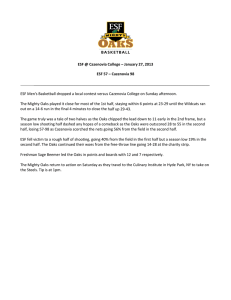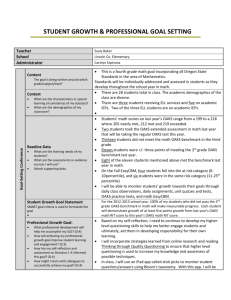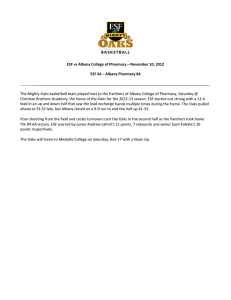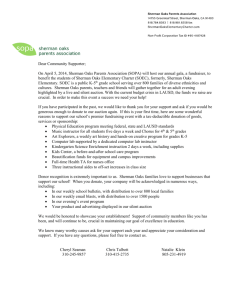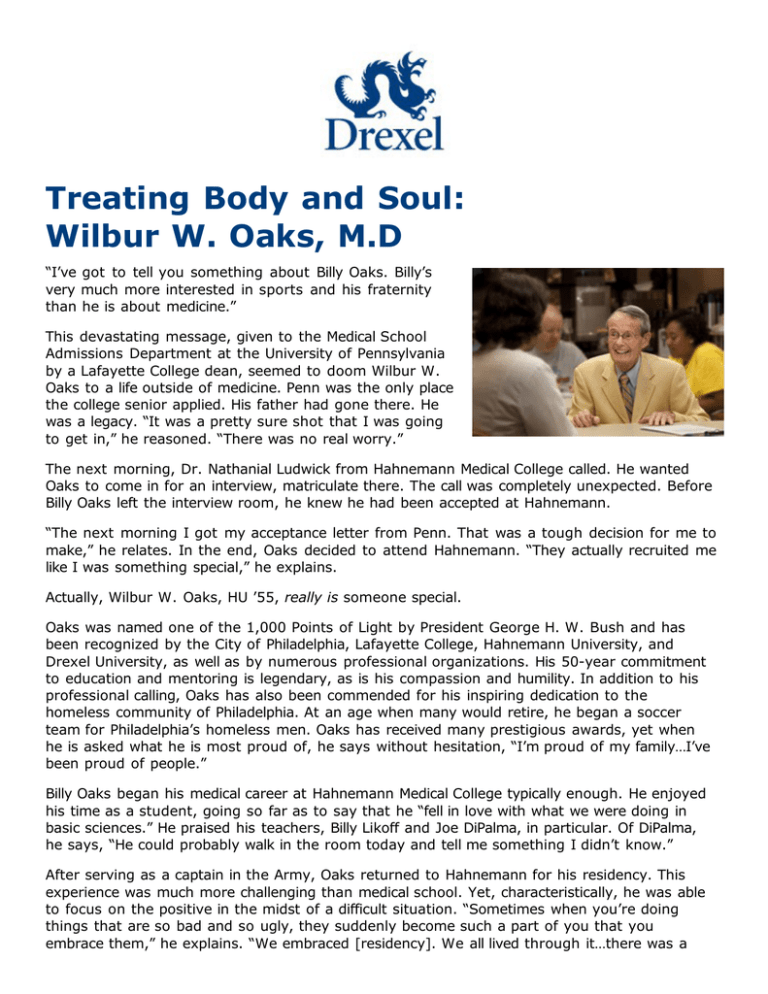
Treating Body and Soul:
Wilbur W. Oaks, M.D
“I’ve got to tell you something about Billy Oaks. Billy’s
very much more interested in sports and his fraternity
than he is about medicine.”
This devastating message, given to the Medical School
Admissions Department at the University of Pennsylvania
by a Lafayette College dean, seemed to doom Wilbur W.
Oaks to a life outside of medicine. Penn was the only place
the college senior applied. His father had gone there. He
was a legacy. “It was a pretty sure shot that I was going
to get in,” he reasoned. “There was no real worry.”
The next morning, Dr. Nathanial Ludwick from Hahnemann Medical College called. He wanted
Oaks to come in for an interview, matriculate there. The call was completely unexpected. Before
Billy Oaks left the interview room, he knew he had been accepted at Hahnemann.
“The next morning I got my acceptance letter from Penn. That was a tough decision for me to
make,” he relates. In the end, Oaks decided to attend Hahnemann. “They actually recruited me
like I was something special,” he explains.
Actually, Wilbur W. Oaks, HU ’55, really is someone special.
Oaks was named one of the 1,000 Points of Light by President George H. W. Bush and has
been recognized by the City of Philadelphia, Lafayette College, Hahnemann University, and
Drexel University, as well as by numerous professional organizations. His 50-year commitment
to education and mentoring is legendary, as is his compassion and humility. In addition to his
professional calling, Oaks has also been commended for his inspiring dedication to the
homeless community of Philadelphia. At an age when many would retire, he began a soccer
team for Philadelphia’s homeless men. Oaks has received many prestigious awards, yet when
he is asked what he is most proud of, he says without hesitation, “I’m proud of my family…I’ve
been proud of people.”
Billy Oaks began his medical career at Hahnemann Medical College typically enough. He enjoyed
his time as a student, going so far as to say that he “fell in love with what we were doing in
basic sciences.” He praised his teachers, Billy Likoff and Joe DiPalma, in particular. Of DiPalma,
he says, “He could probably walk in the room today and tell me something I didn’t know.”
After serving as a captain in the Army, Oaks returned to Hahnemann for his residency. This
experience was much more challenging than medical school. Yet, characteristically, he was able
to focus on the positive in the midst of a difficult situation. “Sometimes when you’re doing
things that are so bad and so ugly, they suddenly become such a part of you that you
embrace them,” he explains. “We embraced [residency]. We all lived through it…there was a
huge spirit that was there…. That’s one thing that people
at Hahnemann in those days will tell you. We really were a
family.”
Following residency, Oaks became a professor and
physician at Hahnemann, eventually becoming chair of the
Department of Medicine. He says that at this time, the
school “blossomed” under the leadership of two people:
Joe DiPalma and John Moyer. “They put the medical school
on the map,” he asserts. Hahnemann became nationally
recognized for its advances in cardiac surgery. There was
also a popular symposium series that brought in experts
to discuss current medical issues. The series was found to
be so valuable that the lectures were turned into books.
Oaks states, “These symposiums became so famous, we
kept doing them with different topics…. Every graduating
medical student had a Hahnemann Symposium medical
book under their arm.”
Of this time, Oaks relates, “I couldn’t wait to go to work.”
As chair of Medicine, he spurred three initiatives: the
Physician Assistant program, a Hahnemann-run television
station (funded by a million-dollar federal grant), and an innovative six-year medical education
program with colleges in the Wilkes-Barre area. Physicians were not “going to the outlying
areas,” he explains, and the Hahnemann-Wilkes-Barre program was a way to remedy that.
By the late ’70s and early ’80s, however, Hahnemann was undergoing a difficult transition. As
Oaks explains, “The situation in general started to deteriorate…. Those that came in to take
over weren’t quite what they replaced…. The union gave us all kinds of problems…. We weren’t
allowed in the building…. We’d crash the door and get in…. These were the kinds of things that
were going on as Hahnemann was trying to grow and develop.”
Despite its administrative difficulties, Hahnemann remained dedicated to its students. That
never wavered. Oaks is quick to attest that the school’s educational mission was never at
stake. “We could teach and train the students and the medical residents, and they could go
any place they wanted and they could compete…. If they had a patient in front of them and
that patient needed care, they were going to get appropriate care…. [The students] could
stand on their own two feet.”
Oaks continues to teach as he has for the past 50 years. “I always love the students and the
residents,” he says. “I don’t know what I’d do if I didn’t have the kids to teach.” Today, he can
reflect on the changes at the school and say with confidence, “[We are] very lucky to be the
Drexel University College of Medicine.” He believes that the two institutions needed and
complemented one another. The synergy as the College of Medicine has been “a wonderful
adventure on both sides.”
At the same time Oaks was educating students and healing patients, he was also helping a
very different community: the people of St. John’s Hospice, a homeless shelter in Philadelphia.
He says, “I said I would take care of the people at the hospice, and that I would bring my
students…. That grew.” Every Thursday they also went to Love Park, to provide care for the
homeless outside the shelter system. “That went very, very well and we did it for a long time.”
Oaks explains that he and his students only stopped going to St. John’s when, one 90-degree
summer day, a hospice administrator complained about a female student wearing shorts. Oaks
decided their medical services were not needed as much as he had thought. Ironically, he
returned to St. John’s Hospice about 15 years later as a soccer coach.
Oaks began the Body and Soul Soccer Team, which practices at 44th and Haverford, with men
from St. John’s. Captain of his Lafayette College team and a lifelong soccer enthusiast, Oaks is
the coach. He has more than shooting drills on his mind, though. He says, “If we teach [the
homeless that] if you can take charge of your life and do something good, go out and get seen
by people and play soccer, we’ll try and get you a job…. So far it’s been pretty good.” In 2008,
the City of Philadelphia formally honored and thanked Oaks for his efforts, noting that the
Body and Soul Team “offers opportunities for homeless people in Philadelphia…to develop
successful life skills with the goal of becoming productive citizens.”
This type of service and commitment seems to come naturally to Oaks, who has a professional
reputation of compassion and empathy. Considering this reputation, Oaks thoughtfully recalls
his childhood. His younger brother had cerebral palsy and their mother cared for him
throughout his life. At one point, his sister suffered from tuberculosis. He says that these
kinds of experiences make you “realize what’s for real, what’s important.” Oaks also reflects on
his friendship with Bill Draper, who coached Oaks and his friends in Narberth’s summer
basketball league. He says that it was “not easy, in those days, for a black man to be coaching
10 white kids.” Although the era was filled with racial tension, Oaks says the team did not see
color. Draper “was a great teacher and we just loved him.”
Reflecting on the changes he has seen during his 52-year career in medicine, Oaks focuses on
the big picture rather than his specific experiences at Hahnemann. “The biggest change is the
image we have given the public, and it’s not the image we want to give them,” he observes.
“Medicine used to be a lot of fun. It’s not so much fun anymore.” He also acknowledges that
with this shift in popular opinion about medicine, current medical students have better motives
for entering the profession.
“I think the kids that are in medicine today are in for the right reasons. It used to be that your
dad was a doctor, and you knew you would make a lot of money, and everybody loved and
cared for you – well, that’s all gone. We don’t have any of that now. You go to medical school
for the right reasons: you like science, and you’re a caring person, and you want to do good
things for people. And I think that’s what we’re working on right now with Drexel University….
Now we’re all Drexel…Drexel is our place. We’re certainly happy with where we are right now,
but there will always be a special place in my heart for Hahnemann.”
© Copyright 2013 - Drexel - All Rights Reserved.



